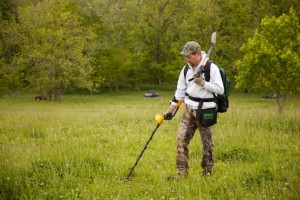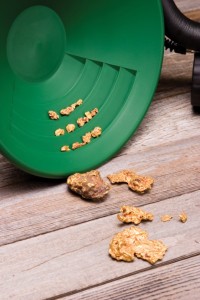Silver and Gold are Waiting to be Uncovered with Metal Detectors

Michael Bernzweig
About the author: Michael Bernzweig manages MetalDetector.com in Southborough, MA. He has written extensively on the subject of metal detecting since the mid 1980’s. He has traveled world-wide in his pursuit of educating, exploring and advising others in the proper use of metal detectors. Outside of the business he enjoys mentoring students, being involved in the community and spending time with his family.
Silver and gold are the two most sought-after metals in the world. Now that they are both at premium prices, more and more people are heading outdoors with metal detector in hand to locate them. The techniques are different for finding gold than for uncovering silver. Silver is more abundantly found (think old coins, jewelry, etc.) and can be detected very easily. Detecting gold requires a little more expertise.
On a Quest for Silver?
 Experts say that almost every square inch of soil can be searched for silver. Favorite spots include farmer’s fields that were trafficked centuries ago and the sites of old battle fields. Silver Spanish coins from the early 1800s are often found in colonial fields. And very old coins from the first U.S. mints can be found where people congregated and/or exchanged money. The United States’ first mint was erected in Philadelphia in 1792- when silver was in abundance. Hence, metal detectorists are on the hunt for those early silver coins. One hobbyist reported finding an 1839-O half dime, Seated Liberty coins, three Shield nickels and two 1850s half dimes in one outing! Silver coins have been found in bunches at old Colonial tavern sites; abandoned trash pits often yield silver relics such as military buttons, shoe and belt buckles and pocket watch parts.
Experts say that almost every square inch of soil can be searched for silver. Favorite spots include farmer’s fields that were trafficked centuries ago and the sites of old battle fields. Silver Spanish coins from the early 1800s are often found in colonial fields. And very old coins from the first U.S. mints can be found where people congregated and/or exchanged money. The United States’ first mint was erected in Philadelphia in 1792- when silver was in abundance. Hence, metal detectorists are on the hunt for those early silver coins. One hobbyist reported finding an 1839-O half dime, Seated Liberty coins, three Shield nickels and two 1850s half dimes in one outing! Silver coins have been found in bunches at old Colonial tavern sites; abandoned trash pits often yield silver relics such as military buttons, shoe and belt buckles and pocket watch parts.
Metal Detectors for Hunting Silver
All metal detectors are programmed to locate silver. Tuning a detector for maximum results depends on how many trash targets the detectorist can tolerate. All-metal mode will provide maximum depth of detection on most units. If the detector has target ID and it is operational in the all-metal mode, you can use that and ID each target that you detect. If it requires being in the discriminate mode to ID, just set the discriminate level to minimum and ID each target.
Finding Ever-Elusive Gold
 Gold jewelry and trinkets are more widespread (therefore, easier to find) than gold nuggets. Finding gold is a dream of many—and it is possible to locate gold flakes and nuggets with a metal detector. Veteran gold prospectors advise that you should travel to places where gold is known to have been found if you’re serious about tracking it down. States that often produce gold finds include Alabama, Arizona, California, Georgia and Nevada. What type of metal detector should you use for finding nuggets?
Gold jewelry and trinkets are more widespread (therefore, easier to find) than gold nuggets. Finding gold is a dream of many—and it is possible to locate gold flakes and nuggets with a metal detector. Veteran gold prospectors advise that you should travel to places where gold is known to have been found if you’re serious about tracking it down. States that often produce gold finds include Alabama, Arizona, California, Georgia and Nevada. What type of metal detector should you use for finding nuggets?
Most manufacturers now make detectors specifically for hunting gold nuggets. For the most part, unless the detector is a multipurpose type, there is not a true discriminate mode. You just tune for maximum depth and take your chances. This is because the combination of metals is not known with nuggets, so it could be detected in any segment of the discrimination scale. Since a nugget can mimic many other metals, why take a chance on missing a great find? Some gold-hunting detectors feature an audio mode that tells the operator if the target is a probable iron target. This way, you aren’t digging up every single signal.
Best Detectors for Gold Prospecting
If you are looking to locate natural gold, there are several gold metal detectors crafted specifically for what a prospector needs. Prospecting models have special circuits and unique search coils designed to locate the tiniest gold nuggets in the toughest conditions. Gold detectors come in two main varieties: high frequency VLF designs and Pulse Induction designs.

